
Washington is a city in Beaufort County, North Carolina, United States, located on the northern bank of the Pamlico River. The population was 9,875 at the 2020 census. It is the county seat of Beaufort County. It is commonly known as "Original Washington" or "Little Washington" to distinguish it from Washington, D.C. The closest major city is Greenville, approximately 20 miles (32 km) to the west.

Beaufort is a town in and the county seat of Carteret County, North Carolina, United States. Established in 1713 and incorporated in 1723, Beaufort is the fourth oldest town in North Carolina . On February 1, 2012, Beaufort was ranked as "America's Coolest Small Town" by readers of Budget Travel Magazine.

Beaufort is a city in and the county seat of Beaufort County, South Carolina, United States. Chartered in 1711, it is the second-oldest city in South Carolina, behind Charleston. Beaufort is known as the "Queen of the Carolina Sea Islands". The city's population was 13,607 at the 2020 census. It is part of the Hilton Head Island–Bluffton metropolitan area.

Bluffton is a town in southern Beaufort County, South Carolina, United States. The population as of the 2020 census was 27,716, an increase of over 120% since the 2010 census, making it the 17th-most populous municipality and one of the fastest growing municipalities in South Carolina. It is primarily located around U.S. Route 278, between Hilton Head Island and Interstate 95. The Lowcountry town's original one square mile area, now known as Old Town, is situated on a bluff along the May River. Bluffton is a primary town within the Hilton Head Island-Bluffton-Port Royal, SC Metropolitan Statistical Area.
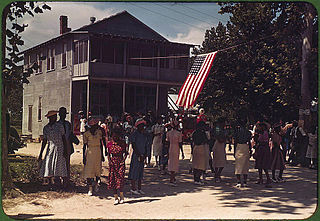
St. Helena Island is a Sea Island in Beaufort County, South Carolina, United States. The island is connected to Beaufort by U.S. Highway 21. The island has a land area of about 64 sq mi (170 km2) and a population of 8,763 as of the 2010 census. It is included as part of the Hilton Head Island-Beaufort Micropolitan Area. The island is renowned for its rural Lowcountry character and being a major center of African-American Gullah culture and language. It is considered to be the geographic influence behind the children's television program Gullah Gullah Island.

Beaufort Historic District is a historic district in Beaufort, South Carolina. It was listed on the National Register of Historic Places in 1969, and was declared a National Historic Landmark in 1973.

The Palmer-Marsh House is a historic house museum and National Historic Landmark on Main Street south of Carteret Street in Bath, North Carolina. Built in 1744, it is one of the oldest residences in North Carolina, and is a well-preserved example of a large colonial town house with a commercial space built in. It was declared a National Historic Landmark in 1970. It is now a North Carolina state historic site, and is open for tours.
The Oaks, also known as the Cooler House, is a historic plantation house located on Saint Helena Island near Frogmore, Beaufort County, South Carolina. It was built about 1855, and is a two-story, vernacular frame I-House. Edward L. Pierce chose The Oaks as his headquarters during the military occupation of St. Helena during the American Civil War. The Oaks was the center for military and agricultural activities on the island. On June 18, 1862, Ellen Murray, who had ten days earlier arrived from Pennsylvania, opened the Penn School for Freedmen in a back room of the house. The house also served as a hotel for military personnel from Port Royal, superintendents, and teachers.
Little Barnwell Island is a historic archeological site located near Port Royal, Beaufort County, South Carolina. The site consists of two shell and earth mounds located on the eastern side of Little Barnwell Island overlooking Whale Branch. The larger of the two mounds is elliptical and once served as the base for a temple or ceremonial building. The mounds and building were probably constructed during the late Savannah II Period ca. A.D. 1500.
Seaside Plantation, also known as the Edgar Fripp Plantation, is a historic plantation house located on Saint Helena Island near Beaufort, Beaufort County, South Carolina. It was built about 1795 to 1810, and is a two-story, frame dwelling in a transitional Georgian / Federal style. It features one-story hip roofed portico. Seaside was one of the plantations participating in the Port Royal Experiment and had as its labor superintendent Charles Pickard Ware (1840–1921). Charlotte Forten Grimké (1837-1914) also resided at Seaside Plantation. Along with Tombee Plantation, Seaside is one of only a few remaining antebellum plantation houses on St. Helena. Also on the property are the contributing original, brick-lined well, a clapboard shed, a large barn with clapboard siding and tin roof, and a round concrete and oyster shell silo.
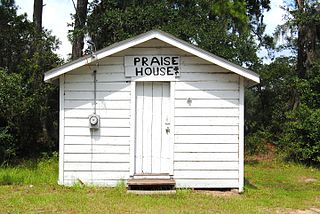
Eddings Point Community Praise House is a historic church located on Saint Helena Island near Frogmore, Beaufort County, South Carolina. It was built about 1900, and is a narrow, one-story gable roofed building of frame construction with the entrance in the gable end. It is significant as one of four known extant African-American praise houses on St. Helena Island, and was a central place in the religious and social life of the black islanders.
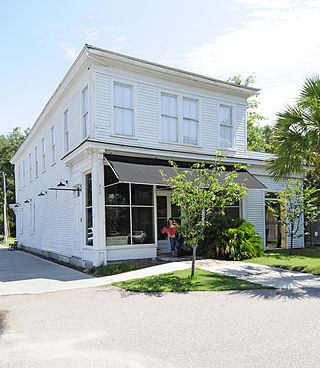
F.W. Scheper Store is a historic general store located at Port Royal, Beaufort County, South Carolina. The store is one of the last remaining 19th century commercial buildings in Port Royal. It was built in 1885, and is a large two-story frame commercial building, with a one-story addition constructed between 1905 and 1912. It is the largest historic commercial building remaining in Port Royal. The store served the community from its construction by German immigrant F.W. Scheper until it closed for business in 1950.

Union Church of Port Royal, also known as Port Royal White Union Church, 11th Street Tabernacle, and Free Church of Port Royal, is a historic church located at Port Royal, Beaufort County, South Carolina. It was completed in 1878, and consists of a one-story, wood frame, brick-piered building with a central entry and portico. It has a cupola containing the church's belfry. It was built with donated lumber by local citizens in 1877–1878 to provide the Port Royal community its only white house of worship at that time.
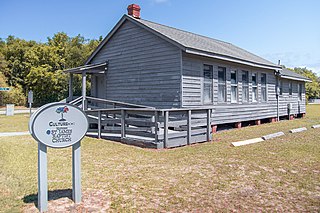
Cherry Hill School is a historic school for African-American students located at Hilton Head Island, Beaufort County, South Carolina. It was the first separate school building for African-American students on the island.

Dennis High School, also known as Dennis Elementary School and Dennis Primary School, is a historic high school building for African-American students located at Bishopville, Lee County, South Carolina. White students attended Bishopville High School, three blocks away. Although the law provided for a separate but equal education, $71,000 was allocated to build Bishopville for the whites while only Dennis was built for $17,000. The expenditures for student at BHS were $48.38 per student, but only $5.68 for each Black student at Dennis. When Dennis High School later burned down, the Black students were just made to double up with the elementary students for 12 years. Dennis was the only school in the county for black students, and no public bus service was provided until 1952.
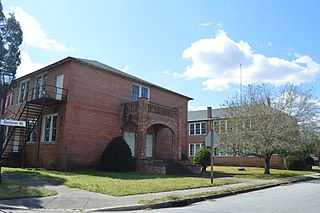
Bath School is a historic school complex located at Bath, Beaufort County, North Carolina. It was built in phases between 1918 and 1966, and consists of two classroom buildings and a classroom and auditorium building connected by a two-story hyphen. Each section is a two-story, brick structure with a hipped roof and Colonial Revival style design details. A kitchen addition was built in 1966. Also on the property are the contributing 1 1/2-story vocational building constructed in 1939 with funds from the Public Works Administration (PWA), one-story shop building built in 1948, and flagpole.

Ware Creek School is a historic Rosenwald school building located at Blounts Creek, Beaufort County, North Carolina. It was built in 1921, and is a one-story rectangular structure with a hipped roof and projecting front pavilions. The main block of the building consists of three classrooms and a projecting central "industrial classroom" under a gable roof. The building exhibits American Craftsman design influences. It ceased use as a school in 1954.
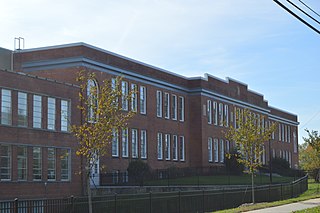
Hillside Park High School, also known as Hillside High School, James A. Whitted Elementary School, and James A. Whitted Junior High School, is a historic school building for African-American students located at Durham, Durham County, North Carolina. The original Classical Revival portion dates to 1922 and is a T-shaped, two-story building on a full basement. A three-story red-brick, T-shaped Modern Movement style addition was built in 1954–1955, with a one-story-on-basement gymnasium rear wing. Also on the property is a contributing greenhouse built about 1960. The school served the African-American student population of Durham until 1970, when the schools were integrated.

Washington Magnet Elementary School is a historic school and building located at Raleigh, Wake County, North Carolina. It was built in 1923-1924 to serve African-American students in Raleigh and is now a magnet elementary school.
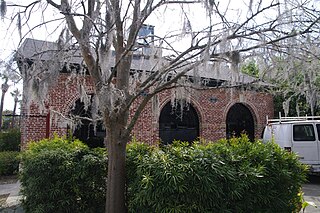
The Reconstruction Era National Historical Park, formerly Reconstruction Era National Monument, is a United States National Historical Park in Beaufort County, South Carolina established by President Barack Obama in January 2017 to preserve and commemorate activities during the Reconstruction Era that followed the American Civil War. The monument was the first U.S. National Monument dedicated to the Reconstruction Era. The John D. Dingell, Jr. Conservation, Management, and Recreation Act, signed March 12, 2019, by President Donald Trump, re-designated it as a national historical park. It is administered by the National Park Service.






















